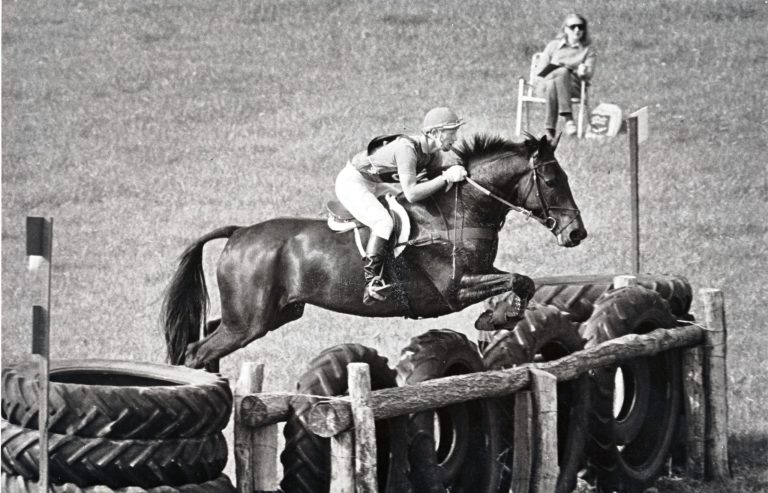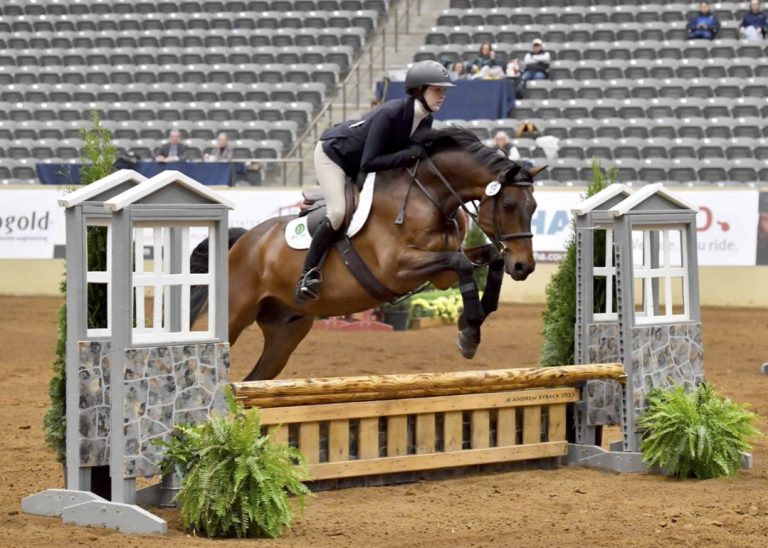 Credit: Courtesy, Las Vegas News Bureau Courtesy, Las Vegas News Bureau
Credit: Courtesy, Las Vegas News Bureau Courtesy, Las Vegas News BureauWin or lose, riding in the FEI show-jumping World Cup final is memorable. The winner of this or that grand prix easily is forgotten—lost in the hundreds that are held each year. And while only five people (four and a reserve) are selected for big team championships, qualifying for the World Cup is done strictly on points without the need for selectors. It gives riders a chance to succeed on their own merits and make the cut. For younger riders who qualify, the competition offers invaluable experience that may someday pay off in a team berth.
The finals have been held mostly in Europe, from Gothenburg, Sweden, to Geneva, Switzerland, and Paris, France, but they also ventured as far afield as Kuala Lumpur, Malaysia. The United States has hosted them eight times, with a ninth, the Longines FEI World Cup Jumping Final to be held April 15–19, in Las Vegas, Nevada. The Reem Acra FEI Dressage Final will be under way at the same time.
Belgian show jumper Olivier Philippaerts first came to Vegas when his father, Ludo, was riding in the final. Olivier spent several weeks last fall on the Indoor circuit in the United States trying to qualify. “When it’s in Vegas, it always makes a difference,” he says, noting how motivated riders are to get there. Why? “You have to see it to believe it. It’s a little bit like a fantasy world.”
Vegas is a welcome break for riders, who have to worry only about competing in one arena without commitments to far-flung rings. And they can enjoy doing something besides riding. “The first time I ever went to Vegas was the first World Cup final they had there. I loved it,” recalls Margie Engle. “There’s always something to do. I don’t think you can have a bad meal. Each hotel is like an experience in itself. There’s something for everyone. I can’t think of anything that you’d want to do that you can’t do there.”
The Gothenburg Crowds
The final that means the most to Leslie Burr Howard is, naturally, the one where she claimed the trophy 29 years ago in Gothenburg, where the final was held every other year in then-sponsor Volvo’s hometown. She was aboard McLain, named after a young McLain Ward, who would grow up to be a serious World Cup contender himself. “What made it exceptionally special was the town of Gothenburg itself,” Leslie remembers. “The crowds there are so educated and among the most enthusiastic in the world.”
The Gothenburg crowd nearly did in Katie Monahan Prudent’s chances in the first final in 1979. “At that time, I had never been to Europe. I had never shown internationally,” she says. “I had seen some of those big riders at our indoor shows because that was at a time when we had the Nations Cups there, but for me, it was like a lightning bolt. I was so wide-eyed, I didn’t have a clue about what I was doing.”
What made it particularly difficult was the “Swedish Bomb.”
“Everybody in the audience would stand pounding their feet as hard as they could,” Katie says. “I had a Thoroughbred, The Jones Boy, who was a very hot horse. When that Swedish Bomb went off, so did his brain. Going into the final jumpoff, I absolutely knew I didn’t have a chance because my horse was so crazed. He was in a lather and his eyes were rolling around in his head. That was all a part of the atmosphere and pressure.”
With determination, Katie persevered despite her frazzled horse to wind up second to Austrian Hugo Simon on Gladstone. It was a turning point in her career. “It was clear to me that was all I wanted to do. I wanted to come back to Europe and compete against the best. I think the World Cup is still a great concept. I love it.”
 Beezie Madden and Simon in 2013 | © Arnd Bronkhorst
Beezie Madden and Simon in 2013 | © Arnd BronkhorstMelanie Smith Taylor won the fourth World Cup final aboard Calypso in 1982, becoming the first female to claim the title. She also had a lot to deal with in Gothenburg, where she first saw the crowd do the wave. Her challenges came from Hugo Simon and Gladstone and Germany’s Paul Schockemöhle and Akrobat.
“The triple combination down the final line looked like a housing development, it was so huge. It seemed to stretch forever, and you had only a few strides out of the corner to set up for it. But the schooling area turned out to be an even bigger test for us than the actual course,” Melanie says.
Paul and Hugo monopolized the two warm-up fences going into the last round. By the time Melanie was called to the ring, she had a chance to jump only three fences under the direction of George Morris.
That was all they had planned to do anyway, which gave Melanie and George a chuckle.
 Credit: © Karl Leck Melanie Smith Taylor became the first woman to win the World Cup final aboard Calypso in 1982. | ©Karl Leck
Credit: © Karl Leck Melanie Smith Taylor became the first woman to win the World Cup final aboard Calypso in 1982. | ©Karl LeckShe had to go clear to win, and that’s what she and Calypso did, finishing the competition without dropping a rail and ending up with the margin of a single penalty over the German rider. She remembers making it through the finish line and wanting “to keep galloping around and around the ring, waving to that fabulous and raucous crowd.”
The spectators worked in her favor, she believes. “I felt I had the support of the crowd. They were behind me.” Their enthusiasm buoyed Calypso, too. “It moved him up and made him better,” she says.
Beezie Madden, who won in Gothenburg two years ago, cites the fans as an element that added to her special victory aboard Simon. “They’re amazing there,” she says. “They appreciate good sport and root for their home team, as they should, but they also appreciate a good ending,” no matter who wins.
As for Vegas as a Cup location, Beezie says, “It’s a super atmosphere—the crowds are excellent. It’s a little smaller venue and a little more electric atmosphere. Any championship we can have in this country is a boost for us.”
The Footing Debacle
The 1987 final in Paris was the first (and last) held in that city, but it nearly didn’t happen. There was a problem with the footing, which was like quicksand. “When we got there, we couldn’t even ride on it,” says Katharine Burdsall, who was there with The Natural, her 1986 world championships team gold-medal mount. She remembers having to walk him out on the pavement to exercise him because the ring could not be used.
 Katharine Burdsall and The Natural in 1987 | © Tish Quirk
Katharine Burdsall and The Natural in 1987 | © Tish QuirkA rider boycott prompted show management to fix the ground overnight, setting the stage for a wonderful final. The crowds were vocal and enthusiastic, but as Katharine notes, “I was such a focused competitor that I don’t think I really let emotions affect me. I had a specific plan about how to approach the course, and in the schooling area, I had it planned down to exactly what kind of jump I wanted every jump to be. I was confident in my horse.” She had reason to be—she won the first segment of the final.
When Katharine was riding in to the award ceremony for the final’s second of three legs, where she was the runner-up to France’s Philippe Rozier on Malesan Jiva, she suddenly took notice of the size of the fences she had just cleared. “Riding in between some of those jumps, I was like, ‘Whoa, these jumps are huge,’” she says.
On the third day, Katharine, who had just ridden, didn’t watch her chief rival, hometown favorite Philippe, who needed a clean round. When she heard the crowd groan as he dropped a rail, she reminded herself it wasn’t politically correct to jump up and down. She was the winner on 4.5 penalties. Philippe wound up second with 7.5. Finally, she could breathe.
The victory “definitely was unreal for me,” said Katharine, who rode back to the hotel on the Paris metro with her trophy. “It hit me later, what had happened, what we were able to accomplish,” she says. Katharine now brings along young prospects but shows rarely. The mother of two, Kyle, 17, and Melanie, 15, she is considering a trip to the Vegas final this spring for fun, noting she has never visited the city.
Ending a U.S. Drought
Katharine’s victory was the seventh for a U.S. rider in the first nine years of the Cup. But it would be a quarter-century until another U.S. rider won. That honor belonged to Rich Fellers in 2012 aboard the indefatigable stallion Flexible, who went on to be the highest-placed horse on the Olympic show-jumping team four months later.
 Rich Fellers and Flexible in 2012 | © Pierre Costabadie/arnd.nl
Rich Fellers and Flexible in 2012 | © Pierre Costabadie/arnd.nl“That will probably be the most exciting moment in my career,” Rich says. “I don’t anticipate that I’m going to surpass that one. It was extra special, the way in which we won.” On the final day in ‘s-Hertogenbosch, the Netherlands, Rich was tied on a single fault with Steve Guerdat of Switzerland, riding Nino des Buissonnets. This triggered a tiebreaker, not common in the World Cup final.
Rich watched Steve’s jumpoff before it was his turn to go. Clocking in at 26.61 seconds, the Swiss rider’s round “almost looked unbeatable,” Rich says. But Flexible, the oldest horse in the competition at age 16, was up to the challenge. “When I came across the finish line and I looked up at the timer”—which read an amazing 25.97 seconds—“I don’t think I’m ever going to experience that [feeling] again in my career.” Rich’s first response was “admiration and respect for my horse. I just knew he could do it.”
Second in the 2008 final with Flexible, Rich took him to the 2009 final in Vegas, where he loves to compete. “It’s always great for any athlete to have what you’d refer to as a home crowd,” Rich says.
At the end of 2014, he led the West Coast League, hoping to qualify Flexible.
Retirement is not in the picture yet for the horse. “He’s as good as ever. I don’t even think of his age anymore. It’s just a reference number. It really means nothing about a horse’s capabilities.” The horse, now 19, has not lost any physical ability, coordination or strength. “Until he tells me that, until I feel that, I will continue on,” Rich says. “He loves jumping.”
This article originally appeared in the March 2015 issue of Practical Horseman.










